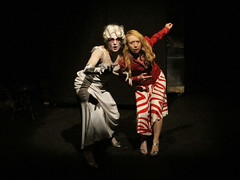With the Living Theatre having raised less than half the money it’s seeking in order to stave off eviction, it’s a fitting time for a play about the woes of a theater company.
“155 First Avenue (The Epic Adventures of the Theater for the New Syzygy),” now showing at Theater for the New City, portrays a theater company in New York struggling against financial strains and decades of neighborhood change. Playwright Toby Armour has made the theater itself the main character through his strong and versatile writing, and the actors in the play are facets of the artistic community.
The lifeblood of the theater is a woman named Lily Field, smartly played by Jennifer Koller. The first act presents her reminiscing in the basement of 155 First Avenue. Her guides through the past are ghosts: Molly Picon, Caroline Astor, Walt Whitman, Peter Stuyvesant, and Jake, a Jewish peddler who, starting from the beginning of time itself, recounts the series of “miracles” that led to the theater’s current location. These four, a wonky Greek chorus commenting on the passing of time, are expertly drawn caricatures. Chris Zorker is particularly hilarious as the puritanical Stuyvesant, lamenting the demise of his orchards and condemning frivolities like theater to Hell.
Yet he is only ridiculous because it is an act; the danger people like Stuyvesant present to the arts is treated seriously, and an unspoken theme of the piece is that artists must continue to justify the creation of new art.
If the first act of the play is Armour’s heartfelt homage to TNC’s past, as well as that of independent theater at large, the second act marks a shift to the present. Gone are the ghosts, and we see the anxieties of a theater company’s existence: bills, rehearsal schedules, and the burden of finding grant money occupy Lily’s mind. When denied a large grant that would have ended the threat of eviction, she is forced to consider an offer from Ronald DaVinci, a slick businessman guilefully played by Jack Luceno. He wants to collaborate on the first ever subterranean shopping mall. It would be “perfectly regulated,” “one perfect day after another after another after another” — in short, it would be Hell.
Armour weaves strands of Greek tragedy and Yiddish theater into his play, embellishing a simple plot with great jokes and memorable characters. Peter Dizozza’s incidental music and songs are charming decoration, even supporting a love scene between two of the theater staff which feels more obligatory than necessary.
The only other weakness in the plot concerns the theater’s future: David, a playwright in the company, begins working on a piece about “a love from the beginning” alluded to in the first half of the play, but it is never explained how this production will be paid for, or if it can truly counter the financial woes which seemed insurmountable before. Ultimately, this inconsistency is excusable, because the whole history of the company has been one of struggle, and this struggle is presented as tantamount to being an artist.
As the play speaks through the myriad accents of New York City through the ages, we learn to trust in the future in spite of its uncertainty, and trust that what artists do has always been, is, and will be worthwhile. It is this fundamental belief which elevates George Ferencz’s raucous and joyful production from a mere neighborhood tale to a love song dedicated to art.
“155 First Avenue (The Epic Adventures of the Theater for the New Syzygy),” continues through May 20 at Theater for the New City, 155 First Avenue, between Ninth and 10th Streets; (212) 254-1109.




